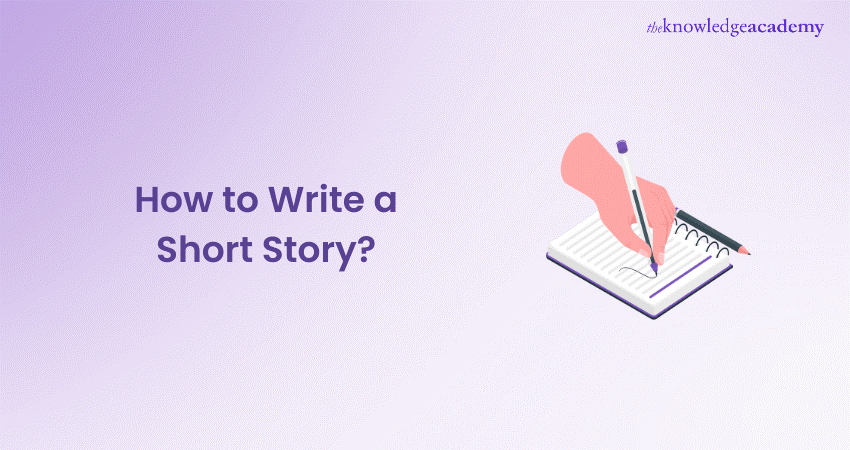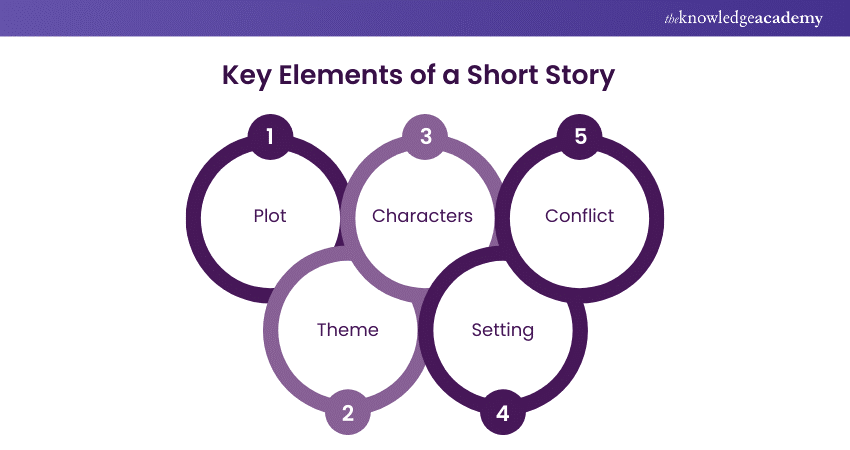We may not have the course you’re looking for. If you enquire or give us a call on 01344203999 and speak to our training experts, we may still be able to help with your training requirements.
Training Outcomes Within Your Budget!
We ensure quality, budget-alignment, and timely delivery by our expert instructors.

If you’re a literature enthusiast, chances are you’ve encountered masterpieces like The Metamorphosis by Franz Kafka, Animal Farm by George Orwell, Birthday Girl by Haruki Murakami, or The Selfish Giant by Oscar Wilde. What do these stories have in common? They leave a lasting impact, resonating with us long after we’ve turned the final page.
These powerful narratives have the ability to transform our perspectives and reshape our understanding of the world. If you aspire to craft such memorable stories, welcome to our blog! Here, in this blog on How to write Short Story; we’ll explore the art of writing Short Stories, guiding you on your journey to becoming a beloved writer.
Table of Contents
1) What Defines a Short Story?
2) Ideal Length for a Short Story
3) Key Elements of a Short Story
4) Steps to Writing a Short Story
5) Conclusion
What Defines a Short Story?
Honestly, there is no hard and fast rule for defining a Short Story. You can call a one-page story a Short Story, so can you with a hundred pages long one. For instance, The Metamorphosis and Animal Farm are considered Novellas by some and Short Stories by others. As the art of writing is subjective, what we want to call the piece of writing is subjective as well.
But, to define a Short Story, we can say that- “Short Stories are a type of narrative writing that contain the same essential elements as novels but are conveyed using far fewer words.” Simply put, Sort Stories allows you to express your thoughts concisely if you know the art of writing them.
Ideal Length for a Short Story
As we discussed, defining the length of a Short Story is completely subjective, but according to some, they typically fall between 1,000 and 10,000 words. But if we take Earnest Hemingway’s six-word Story “For Sale: Baby Shoes, Never Worn.” for instance, it doesn’t fall under this criterion, but it's a Short Story, nonetheless.
Stories with 500 words or fewer are considered to be microfiction, while those under 1,000 words are referred to as flash fiction. Stories ranging from 10,000 to 40,000 words are typically classified as novellas, and once a story reaches around 50,000 words, it is considered a novel. But rules are meant to be broken, you know, right? And if Hemingway can, so can you.
Key Elements of a Short Story
Authors often experiment with various formats and styles in their Short Stories, but they generally incorporate five key elements to create a coherent narrative and captivate the reader. These elements include:

Plot
The plot refers to the series of events in a story, usually structured with an explicit origin, middle, and ending. Generally, the origin introduces the characters and setting, the middle presents the central conflict, and the ending reveals its resolution.
However, this system can differ based on the author's approach; for example, some plots may start in the middle of the action rather than at the beginning.
Characters
Characters are the individuals in a story, often used by writers to drive the plot forward through their actions and dialogue. Common types include the protagonist, the main character whom readers are generally meant to support, and the antagonist, who stands in opposition.
Additionally, there are supporting characters who help develop the story by aiding either the protagonist or the antagonist.
Conflict
Conflicts are the central challenges in a story. They can arise from a character's internal struggles, such as emotions or fears that hinder their goals, or from external sources, like opposition from another character or a challenging environment. Most stories rely on some form of conflict to drive the plot forward.
Theme
A theme is an underlying idea or message woven throughout a story. Rather than stating it outright, authors often use other vital elements, like plot and characters, to subtly express the theme. Themes can vary from comprehensive topics, such as friendship, to more specific viewpoints, such as the belief that friendship holds more significant value than romantic love.
Setting
Setting indicates the time and place in which a story unfolds. It can range from real-world locations and historical periods to entirely fictional worlds. To demonstrate the setting effectively, writers often include details about the weather, season, physical landscape, and cultural environment.
Master your day with Time Management Training. Sign up now!
Steps to Writing a Short Story
Steps do not define creativity, nor can rules confine it. The best step to writing a Short Story is to pick up your pen, typewriter, or laptop, get yourself going, and let your thoughts flow. However, if you are sceptical about where to start, don't worry! We are here for you. You can follow the following steps to get started:
1) Understanding What a Short Story Is Versus a Novel
Short Stories typically range from 1,000 to 10,000 words, falling between flash fiction and a novel. Unlike novels, Short Stories usually have fewer characters, a singular point of view, and a straightforward storyline without subplots.
They tend to limit backstory or exposition, concentrating on a pivotal moment or epiphany. Many impactful Short Stories are centred around a single dramatic event or vignette.
2) Focus on a Simple, Central Idea
A Short Story can emerge from various inspirations—a vivid image, a compelling character, or a memorable incident. At its core, however, it often begins with a simple premise that holds the potential for a deeper narrative.
For instance, Kafka’s The Metamorphosis explores human relationships through the transformation of its protagonist, while Melville’s Bartleby the Scrivener uses a clerk's refusal to work to explore complex themes of individuality and society.
3) Develop a Small, Distinct Cast of Characters
Short Stories generally feature fewer characters than novels, and readers often need less information about them, which can add intrigue. However, creating memorable, distinct characters is key. Each should stand out through appearance, behaviour, or speech patterns.
For instance, in The Yellow Wallpaper, Charlotte Perkins Gilman distinguishes her narrator, while Poe's The Tell-Tale Heart uses speech to define characters. Flannery O'Connor's A Good Man Is Hard to Find achieves character uniqueness, especially with The Misfit.
4) Start Writing Close to the Climax
Kurt Vonnegut advised starting stories close to the end, skipping lengthy exposition. Jump straight into the action to engage readers quickly. An impactful opening line should raise questions and spark curiosity, much like "A shot rang out," which introduces danger and intrigue. Readers seek answers, and an opening that invites questions encourages them to keep reading.
5) Silence Your Inner Critic
When drafting, embrace the "anything goes" mindset. Silence your inner editor and let creativity flow. Don’t worry about overwriting—refinement comes later. If stuck, leave gaps and revisit them, or jot down rough notes instead of full sentences.
Whether you plan or write spontaneously, the key is completing the first draft, regardless of its imperfections.
6) Complete Your First Draft
A powerful ending is important for any Short Story, as it can elevate or undermine the entire narrative. Whether you plan or improvise, aim for an ending that aligns with the story's internal logic without being predictable. Avoid conclusions that leave readers thinking, “Is that it?” or “What just happened?”—both indicate unresolved or confusing endings.
7) Revise and Edit Your Story
Once you have a first draft, the real work begins: revising and refining. Read it multiple times, asking yourself which narrative threads need development, which to add, and which to cut.
The final polish focuses on scrutinising every word and sentence: Is it clear, concise, and free of clichés? This stage brings the story to life, adding the final touches.
8) Share Your Story with Beta Readers
After countless rewrites, you may reach a point where you can’t stand to look at your story. When this happens, set it aside for a while. Upon returning, you’ll see it with fresh eyes, making it easier to cut unnecessary parts and improve the piece.
Once you’re confident, share it with beta readers for feedback. This step is best done when the story feels complete, minimising revisions afterwards.
9) Submit Your Story to Publishers
How do you know when your story is finished? The answer is: when you can't see how to improve it. That's when you can finally step back, be satisfied with your work, and submit it for others to read.
However, there's rarely a "final" draft. Even after acceptance, you might find small tweaks you'd like to make, which a sympathetic editor can usually accommodate before publication.
Boost your focus with our Attention Management Training. Join now!
Conclusion
Writing a Short Story is a creative journey that blends imagination with technique. You can amuse readers by focusing on strong characters, a gripping plot, and a powerful opening. Don’t fear revisions—embrace them as part of the process. With persistence, feedback, and polishing, you'll understand How to Write a Short Story and craft one that captivates and leaves a lasting impact. Happy writing!
Enhance your skills with our Active Listening Training. Sign up now!
Frequently Asked Questions

A Short Story follows a structure with a clear beginning, middle, and end. It includes essential elements like characters, plot, setting, conflict, and theme, all delivered concisely within a limited word count.

The three most famous Short Story types are literary, flash fiction, and genre fiction (such as mystery, fantasy, or science fiction). Each focus on distinct narrative techniques and word limits, catering to different storytelling styles.

The Knowledge Academy takes global learning to new heights, offering over 30,000 online courses across 490+ locations in 220 countries. This expansive reach ensures accessibility and convenience for learners worldwide.
Alongside our diverse Online Course Catalogue, encompassing 19 major categories, we go the extra mile by providing a plethora of free educational Online Resources like News updates, Blogs, videos, webinars, and interview questions. Tailoring learning experiences further, professionals can maximise value with customisable Course Bundles of TKA.

The Knowledge Academy’s Knowledge Pass, a prepaid voucher, adds another layer of flexibility, allowing course bookings over a 12-month period. Join us on a journey where education knows no bounds.

The Knowledge Academy offers various Personal Development Courses, including the Fiction Writing Course, Time Management Training, and Dealing with Difficult People Course. These courses cater to different skill levels, providing comprehensive insights into How to Become Self-Employed.
Our Business Skills Blogs cover a range of topics related to Personal Development, offering valuable resources, best practices, and industry insights. Whether you are a beginner or looking to advance your Business skills, The Knowledge Academy's diverse courses and informative blogs have got you covered.
Upcoming Business Skills Resources Batches & Dates
Date
 Fiction Writing Masterclass
Fiction Writing Masterclass
Fri 21st Feb 2025
Fri 25th Apr 2025
Fri 20th Jun 2025
Fri 22nd Aug 2025
Fri 17th Oct 2025
Fri 19th Dec 2025







 Top Rated Course
Top Rated Course



 If you wish to make any changes to your course, please
If you wish to make any changes to your course, please


